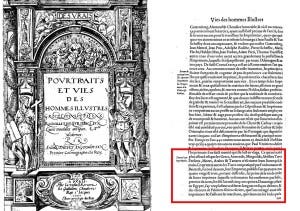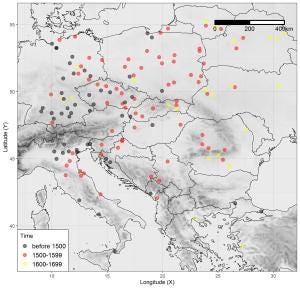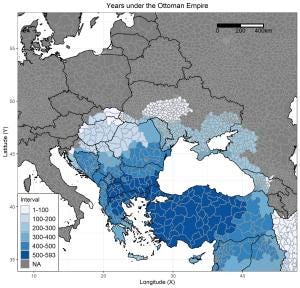Ottoman Governance and Development: The Role of Human Capital
The long-run effects of historical imperial rule on economic development are controversial. We contribute to this debate by considering the role of an experience that is relatively little understood – the Ottoman Empire in Europe. Our new article pursues two objectives: first, to estimate the effects of Ottoman exposure on long-run development by going beyond broad cross-country comparisons, and second, to tackle the difficult issue of the mechanisms underlying any long-run effects. In doing so, we contribute to a body of scholarship which found that imperial rule can have both a negative but also positive impact on development.
In order to evaluate the effect of the Ottoman Empire on long-run development, we collected a series of historical maps and for the first time, we created an index that shows how long different counties in Europe (NUTS-3 level) have been part of the Ottoman Empire. The data is based on a variety of maps in Ottoman (the dead language of the Ottoman Empire), Turkish, Serbo-Croatian, Romanian, French, German, and English. To the best of our knowledge, this is the most comprehensive dataset which captures duration under Ottoman rule.
Legacies of the Ottoman rule for economic development
In our research, we show that Ottoman rule is connected to lower levels of economic development (measured through GDP/capita). Second, we show that human capital accumulation (i.e. education) mediates the relationship between Ottoman rule and economic development. In order words, cross-sectional results indicate that education (and human capital accumulation, more generally) could be an important mechanism for the ways in which Ottoman governance affected economic outcomes in the long-run. These results are highly robust to a variety of specifications and inclusion of controls.
We find a highly robust connection between human capital accumulation and Ottoman rule. Modern survey respondents are more likely to report lower educational achievements for themselves and for their parents, and having had fewer books in childhood. Equally important, longer Ottoman rule is statistically related to fewer printshops and fewer universities in 1700s and 1800s. These results are compatible with the literature connecting the presence of printing presses and educational outcomes. For example, within the colonialism literature, the printing press introduced by Catholic or Protestant missionaries is causally linked to higher subsequent literacy for the populations in the areas where the printing press was set up.
The second part of our research focuses on examining historical differences in social capital between Ottoman and non-Ottoman geographic spaces, and the role of the Ottoman successor states in reducing these differences. Romania is a country whose territory was split between the Ottoman and the Habsburg Empire for over four centuries. We use a geographic regression discontinuity design to investigate how literacy rates in the two territories converged over time.
Results on some of the earliest censuses around the time of independence from the Ottoman Empire (1864) reveal a difference of about 20 percentage points. In other words, there were about 20 percentage points more people who were considered illiterate around the time of the declaration of independence from the Ottoman Empire. These differences however became smaller over time. The Romanian communist regime (1944-1989) played a key role in reducing educational disparities between the two regions. One of the key objectives of the communist regime was to improve access to education, together with using it to promote the communist ideology, and to erase social inequalities. The difference between the former Ottoman and Habsburg regions was around 11% in 1880. This gap was reduced to 7.5% in 1948, 3% in 1977, and 2% in 1992. The difference in literacy rates became statistically negligible in 2002, while there still was a lingering residual disparity in the percentage of population with primary and less than primary school education.
The printing press in the Ottoman Empire
We contend that the limited literacy in the Ottoman Empire can be attributed to the late adoption of the printing press. The Ottomans were first introduced to the printing press by the Spanish Jews who were expelled from Spain in 1492. Despite its early introduction, printing “did not find the favorable environment for it to flourish” (Pektaş, 2015, p. 29). The reason for the slow spread of the printing press is subject to contention among historians. Many historians provide top-down explanations for the slow spread. First, some mention outright prohibition on the press in the 1400s and early 1500s.
Caroline Finkel, for example, suggests that “Sultan Bayezid II…banned all printing and his order was reiterated by Sultan Selim I in 1515 – the crime was punishable by death” (366). The origin of such information is a French Franciscan priest and cosmographer, who wrote in 1584:
“What I know for sure is that the Greeks, Armenians, Mingrelians, Abyssinians, Turks, Persians, Moors, Arabs & Tartars do not write their books except by hand. [And] that among the others, the Turks are constrained by the decree of Baiazeth, second in name, their Emperor [i.e., Bayezid II], published in the year fourteen hundred eighty-three, carrying the prohibitions, on the pain of death to not consume printed books, which was the ordinance confirmed by Selim, first of name [i.e., Selim I], his son, [in] the year one thousand five-hundred fifteen. (emphasis added)” (Thevet, 1584, p. 514)
The cover of Thevet’s book together with page 514 which was used by generations of historians as evidence for the existence of a ban on the printing press in the Ottoman Empire is displayed below.

Modern historians, however, question whether this prohibition ever existed, given that official documents to indicate it, cannot be located. Other historians mention the Ottoman elites’ awareness about the negative effects of the printing press for state security. A third group of scholars mention socio-political interests within government circles in the Ottoman Empire, specifically the opposition of Ottoman scribes or calligraphers, whose very job depended on the manual copying of manuscripts, the palace correspondence, financial accounts, and land tenure documents.
Irrespective its root causes, the late and limited adoption of the printing press resulted in the publication of only 142 books between 1726 and 1838 in the Ottoman Empire. This is a very small number compared to the 30,000 different books that had already been published in the West by 1500. The substantially lower density of printing presses in the Ottoman empire as of 1700 is also visible in the map below.

Implications of our research
This study makes two contributions to our understanding of the long-run effects of political institutions. First, we provide evidence for a causal channel related to human capital accumulation for these effects in the case of an empire governing in Central and Eastern Europe for over five centuries. Second, we provide evidence for a causal channel related to human capital accumulation for these effects.
We argued that a key component of this channel in the Ottoman case was the delay in the widespread adoption of the printing press. The connection between the printing press and mass literacy has already been documented. These accounts and our historical evidence point towards the printing press being a necessary but not sufficient condition for the development of mass literacy. When combined with the limited investment in the provision of mass education, the late adoption of the printing press helps explain the lower level of human capital accumulation in the empire.


